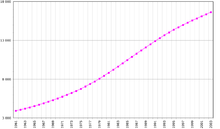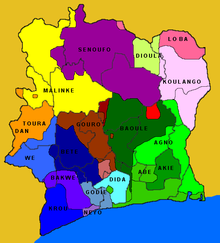- Demographics of Côte d'Ivoire
-
This article is about the demographic features of the population of Côte d'Ivoire, including population density, ethnicity, education level, health of the populace, economic status, religious affiliations and other aspects of the population.
Contents
Ivoirian diaspora
The table below shows the number of people born in Côte d'Ivoire who have migrated to OECD countries only (the table only includes communities consisting of at least 1,000 members).[1]
Country Côte d'Ivoire-born population See also  France
France457,231  United States
United States7,595  Italy
Italy7,242  United Kingdom
United Kingdom2,794 Ivoirians in the United Kingdom  Canada
Canada1,865  Belgium
Belgium1,363  Switzerland
Switzerland1,100 CIA World Factbook demographic statistics
The following demographic statistics are from the CIA World Factbook, unless otherwise indicated.
Population
- 21,058,798 (2010 est.)
- Note: estimates for this country explicitly take into account the effects of excess mortality due to AIDS; this can result in lower life expectancy, higher infant mortality and death rates, lower population and growth rates, and changes in the distribution of population by age and sex than would otherwise be expected (July 2010 est.)
Age Structure
- 0-14 years: 40.6% (male 4,215,912/female 4,146,077)
- 15-64 years: 56.6% (male 5,942,642/female 5,720,108)
- 65 years and over: 2.9% (male 296,074/female 296,255) (2010 est.)
Median age
- Total: 19.6 years
- Male: 19.7 years
- Female: 19.5 years (2011 est.)
Birth rate
- 31.48 births/1,000 population (2010 est.)
Death rate
- 10.43 deaths/1,000 population (2010 est.)
Sex ratio
- At birth: 1.03 male(s)/female
- Under 15 years: 1.02 male(s)/female
- 15-64 years: 1.04 male(s)/female
- 65 years and over: 0.99 male(s)/female
- Total population: 1.03 male(s)/female (2011 est.)
Infant mortality rate
- Total: 89.11 deaths/1,000 live births
- Male: 105.73 deaths/1,00
live births
- Female: 71.99 deaths/1,000 live births (2006 est.)
Life expectancy at birth
- Total population: 56.19 years
- Male: 55.27 years
- Female: 57.13 years (2010 est.)
Total fertility rate
- 4.01 children born/woman (2010 est.)
HIV/AIDS
- Adult prevalence rate: 7.2% (2005 est.)
- People living with HIV/AIDS: 750,000 (2005 est.)
- Deaths: 65,000 (2005 est.)
Major infectious diseases
- Degree of risk: high
- Food or waterborne diseases: bacterial diarrhea, hepatitis A, and typhoid fever
- Vectorborne diseases: malaria, yellow fever, and others are high risks in some locations
- Water contact: schistosomiasis (2005)
Nationality
- Noun: Ivoirian(s)
- Adjective: Ivoirian
Ethnic groups
- Akan 42.1%, Voltaiques or Gur 17.6%, Northern Mandes 16.5%, Krous 11%, Southern Mandes 10%, other 2.8% (includes 30,000 Lebanese and 45,000 French) (2004)
- Côte d'Ivoire has more than 60 ethnic groups, usually classified into five principal divisions: Akan (east and center, including Lagoon peoples of the southeast), Krou (southwest), Southern Mandé (west), Northern Mandé (northwest), Sénoufo/Lobi (north center and northeast). The Baoulés, in the Akan division, probably comprise the largest single subgroup with 15%-20% of the population. They are based in the central region around Bouaké and Yamoussoukro. The Bétés in the Krou division, the Sénoufos in the north, and the Malinkés in the northwest and the cities are the next largest groups, with 10%-15% of the national population. Most of the principal divisions have a significant presence in neighboring countries.
- Of the more than 5 million non-Ivorian Africans living in Côte d'Ivoire, one-third to one-half are from Burkina Faso; the rest are from Ghana, Guinea, Mali, Nigeria, Benin, Sénégal, Liberia, and Mauritania. The non-African expatriate community includes roughly 50,000 French (this number may be inaccurate due to the evacuation of roughly 8,000 Frenchmen in November 2004) and possibly 30,000 Lebanese. The number of elementary school-aged children attending classes increased from 22% in 1960 to 67% in 1995.
Religions
- Muslim 35-40%, indigenous 25-40%, Christian 20-30% (2001)
- note: the majority of foreigners (migratory workers) are Muslim (70%) and Christian (20%)[2]
Languages
- French (official), 60 indigenous languages, of which the Dioula dialect of Bambara is the most widely spoken. Other languages include: the Gur languages, the Senufo languages, the Kru languages (including the Bété languages, Dida, Nyabwa, Wè, and Western Krahn), and the Kwa languages from which Baoulé and Anyin are notably used.
Literacy
- Definition: age 15 and over can read and write
- Total population: 50.9%
- Male: 57.9%
- Female: 43.6% (2003 est.)
References
 This article incorporates public domain material from the CIA World Factbook document "2006 edition".
This article incorporates public domain material from the CIA World Factbook document "2006 edition".- ^ "Country-of-birth database". Organisation for Economic Co-operation and Development. http://www.oecd.org/dataoecd/18/23/34792376.xls. Retrieved 2010-06-25.
- ^ Field Listing - Religions, CIA World Factbook. www.cia.gov last updated on 19 June 2008.
Demographics of Africa Sovereign
states- Algeria
- Angola
- Benin
- Botswana
- Burkina Faso
- Burundi
- Cameroon
- Cape Verde
- Central African Republic
- Chad
- Comoros
- Democratic Republic of the Congo
- Republic of the Congo
- Côte d'Ivoire (Ivory Coast)
- Djibouti
- Egypt
- Equatorial Guinea
- Eritrea
- Ethiopia
- Gabon
- The Gambia
- Ghana
- Guinea
- Guinea-Bissau
- Kenya
- Lesotho
- Liberia
- Libya
- Madagascar
- Malawi
- Mali
- Mauritania
- Mauritius
- Morocco
- Mozambique
- Namibia
- Niger
- Nigeria
- Rwanda
- São Tomé and Príncipe
- Senegal
- Seychelles
- Sierra Leone
- Somalia
- South Africa
- South Sudan
- Sudan
- Swaziland
- Tanzania
- Togo
- Tunisia
- Uganda
- Zambia
- Zimbabwe
States with limited
recognition- Sahrawi Arab Democratic Republic
- Somaliland
Dependencies and
other territories- Canary Islands / Ceuta / Melilla / Plazas de soberanía (Spain)
- Madeira (Portugal)
- Mayotte / Réunion (France)
- Saint Helena / Ascension Island / Tristan da Cunha (United Kingdom)
- Western Sahara
Categories:- Ivorian society
- Demographics by country
Wikimedia Foundation. 2010.


